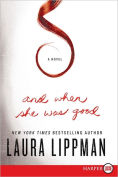While in line at Starbucks, small businesswoman and single parent Heloise Lewis learns of the apparent suicide of the so-called “suburban madam”. She hears the woman behind her patronisingly mocking the dead woman’s mental health and—in an action that might seem odd to anyone not from Baltimore—turns to confront her. Heloise defends the dead woman, arguing that prostitution is a victimless crime and, further, that as a person the woman deserves more respect than to have her entire life summed up in two words. She was “‘Someone’s daughter, someone’s sister, someone’s mother.’” Like Heloise herself.
This 2012 stand-alone from the popular author draws us irresistibly into Heloise’s life, a life she’s fabricated out of her damaged past to protect herself, her son, and her employees. Chapters alternate between Heloise’s history and the present where her carefully constructed life is under siege from an increasing number of threats.
Lippman deals out these threats with care. She follows up the surprise of Heloise’s profession with an account of the moment when as a child, then called Helen, her father first turns on her the anger and fists previously reserved for Helen’s mother. Then in the present, Heloise suffers the small betrayal of one of her oldest and favorite clients asking for someone new on his next visit.
By this time it was hard for me not to identify with Heloise and feel so firmly on her side that I could not abandon her when a worse threat is revealed: the possibility that her son’s father, a gangster and murderer, might be released from prison. I could not distance myself, thinking that such a thing would never happen to me. I could understand only too well how I might have gone down that path.
As K.M. Wieland describes in her blog for writers, it is a character’s backstory (or history) that makes a reader identify with her. As Lisa Cron says, backstory is “what gives meaning to everything that is happening up there on the surface” of the story. The trick, of course, is to weave it in carefully so it doesn’t overwhelm the story. With the parallel stories of Heloise’s past and present, Lippman doubles the difficulty. The difference in names–Helen and Heloise–helps keep the reader oriented between the two stories.
There are more betrayals, large and small, as Heloise struggles to save her life and the lives of her sons and colleagues. For me, the great joy of this book, aside from its powerful momentum, is the way Lippman details the inner workings of Heloise’s business. She’s thought through even minor details such as Heloise providing bracelets with GPS chips for her employees. When they leave her employ, they can have the chip removed and keep the bangle as a souvenir.
Even better is the way Lippman presents Heloise’s approach to running her business. It reminded me of Stringer Bell taking economics classes to better manage drug kingpin Avon Barksdale’s business in The Wire. It only makes sense, of course. A business is a business. Yet it keeps the reader identifying with Heloise even as we venture into less familiar territory.
As always with a Lippman novel, even as I’m racing to the end to find out what happens, I’m aware as a writer of bits of information falling into place, even those that seemed random or extraneous. I resisted this book for a long time because I so loathed the misogyny of the Philip Roth novel that the title pays tribute to that I not only threw it out but also tore it up first so no one else would suffer from its poison. However, I’m happy to recommend Lippman’s book as a supremely satisfying read.
Have you read any of Laura Lippman’s books? Which one is your favorite?

